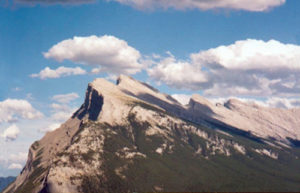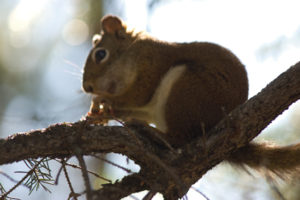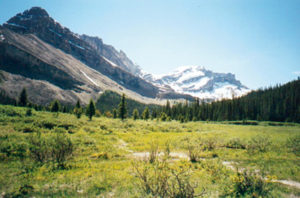Distance
After travelling 2.4 km through a subalpine forest alongside Corral Creek, you’ll find the forest becoming sparse and then finally opening into a meadow. There is only 900 m remaining to the campground, so take your time in this openness. Stop, look, listen and smell. Tourists have been passing through this same spot for at least 76 years; the history can be felt here. As the trail approaches the campsite, the history can also be seen as the Halfway Hut comes into view on the right at 7.1 km. There is well-marked signage showing the way to the hut and the campground to the left. The hut was used mainly in the winter as a stopover for guests on the way to Skoki Lodge. Standing outside the door of the Halfway Hut looking southwest, enjoy the view of the looming, snowcapped peak of Mount Temple.
Going back to the main trail, carry on up to the Hidden Lake campground junction and turn in to the campground. It is not situated on the lake as the name suggests, but the lake can be explored 1.2 km north of the campground. This typical Rocky Mountain tarn lies beneath Pika Peak and Mount Richardson, both of which are within 1.2 km of the lake but appear much closer. The trail of this short hike to Hidden Lake is surrounded by beautiful wildflowers. If a day hike to Skoki Lodge is too overwhelming, Boulder Pass (Ptarmigan Lake), Deception Pass and Baker Lake are all easily accessible, at another 1.5, 3.9 and 6.1 km respectively. At kilometre 10.5 on the Skoki Valley Trail (3.4 from Hidden Lake Campground) is the signed junction for Baker Lake to the right and Deception Pass to the left. Either trail leads to Skoki Lodge, but the Deception Pass route is the quickest, with 3.9 km to travel from the junction.
History
This campground is the gateway to the Skoki backcountry area. Skoki Lodge was constructed as a ski resort in 1930, with the first guests arriving in the spring of 1931. It was the first one of its kind in western Canada. The lodge was built for Cyril Paris and Cliff White by Earl Spencer, and their structure is still fully operational today, welcoming guests throughout the summer and winter seasons.
Although he was certainly not the first explorer in the area, James Porter named the region during a 1911 journey. The name was originally spelled “Skokie” in his notes, but that was eventually assimilated to Skoki over the passing years. Porter took the name for the region from a Potawatomi Illinois Indian tribe word meaning “swamp” or “bog.” He also took the liberty of naming many other natural features nearby, including the Wall of Jericho, Protection Mountain, Merlin Castle, Tilted Mountain, Skoki Mountain and two lakes: Douglas and Redoubt.
The Halfway Hut in the Hidden Lake region was built as a resting place, shelter from storms and an overnight stay for tourists bound for Skoki Lodge. It’s a spartan facility, yet a haven of warmth and comfort for many travellers caught in a winter’s storm. After perishing in an avalanche while skiing in 1933, a lodge guest from Boston, Massachusetts, was said to have haunted the Halfway Hut for many years afterward. Dr. Raymond Edwin Allen Christopher Paley set out from the lodge to ski unaccompanied after lunch on April 7. He departed without notice and proceeded up the side of Fossil Mountain, which had been deemed extremely unsafe just that same day. As he neared the top of the slope an avalanche slab gave way, taking Dr. Paley with it. No one knows what prompted his action, apart from Paley himself. Sadly, he was only 25 years old.
Directions
Leaving the village of Lake Louise, head north over the Highway 1 overpass up Whitehorn Road. Turn right onto Fish Creek Road at 1.7 km and then continue for an additional 1 km until you reach the parking lot.






